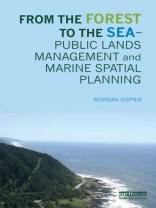The management of common pool resources and publicly-owned areas is fraught with difficulty. This book explores the long, complex, and frequently contentious history of public lands management in the United States in order to draw lessons for the emerging field of marine spatial planning (MSP).
The author first establishes that these two seemingly different settings are in fact remarkably similar, drawing on established theories of policy analysis. The work then examines the management of US National Forests over the past 120 years, including three place-based case studies, to discover recurring themes. The analysis shows how different management approaches evolved over time in response to changing laws and cultural norms, producing outcomes favored by different constituencies. This history also reveals the ambiguities and contradictions inherent in multiple-use management of any public space. Next, the book analyzes recent efforts to advance MSP, both in the US and globally, showing how they mirror past experiences in National Forest management, including similar disagreements among stakeholders.
In conclusion the author suggests how those within ocean-related sectors – government, academia, industry, and environmental groups – might achieve their individual and collective goals more effectively based on lessons from the public lands setting.












